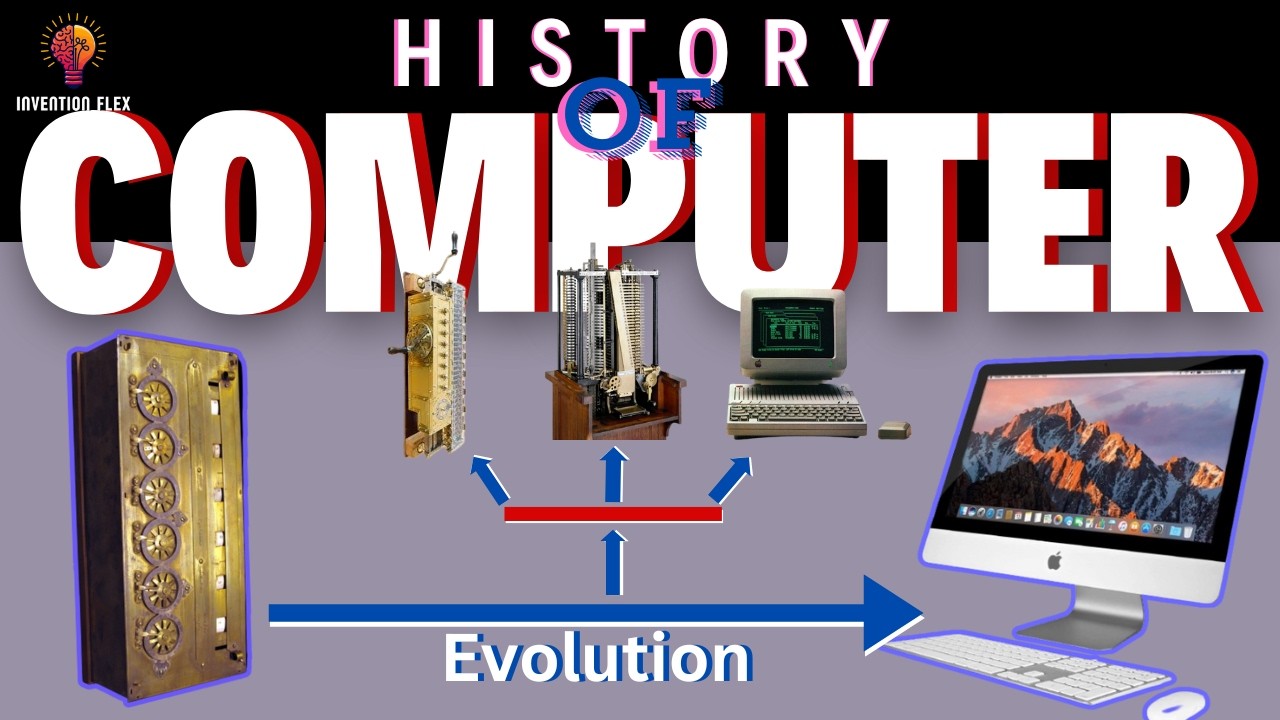How Computers Evolved? History Of Computers From 1642 To 2022
Summary
TLDRThis video script by Sidhart from The World of Science traces the evolution of computers from the abacus to modern laptops. It highlights key developments like Blaise Pascal's mechanical calculator, Charles Babbage's Difference Engine, punched card programming, and the ENIAC. The script outlines computer generations, from vacuum tube-based machines to integrated circuits and VLSI, leading to personal computers. It concludes with the advent of fifth-generation computers featuring AI and looks forward to future advancements.
Takeaways
- 🧮 The term 'computer' originally referred to a device or person that performs calculations.
- 📚 The need for computers arose from the requirement to handle complex calculations and store vast amounts of data beyond the capacity of simple tools like the abacus.
- 🏛️ Early mechanical calculators were invented in Europe during the 16th-17th centuries, with Blaise Pascal's invention of a mechanical calculator in 1642.
- 🔩 Charles Babbage's 'Difference Engine' in 1822 marked a significant step towards modern computer systems, being an automatic mechanical calculator.
- 💾 Herman Hollerith's invention of punched cards revolutionized data storage and processing, leading to the formation of IBM in 1924.
- 🔄 The Harvard Mark I, completed in 1944, was an early electro-mechanical computer that used punch cards for input and output operations.
- 🚀 World War II accelerated the development of computers, culminating in the creation of ENIAC in 1946, the first fully digital computer using vacuum tubes.
- 📈 The first generation of computers (1950-1959) utilized vacuum tubes for logical operations and ferrite cores for memory, making them large and expensive.
- 💿 The second generation (1959-1969) introduced semiconductors, making computers faster, more reliable, and less expensive, with the use of magnetic tape for storage.
- 🛠️ The third generation (1969-1977) saw the use of Integrated Circuits, significantly reducing computer size and increasing processing capabilities.
- 💻 The fourth generation, starting in the 1980s, brought Very Large Scale Integration, leading to the widespread adoption of personal computers and the introduction of portable PCs.
Q & A
What was the primary purpose of the earliest computers?
-The primary purpose of the earliest computers was to perform bigger calculations and store large amounts of information that a simple calculator could not handle.
What is the earliest known computing device?
-The earliest known computing device was the abacus, a simple tool with parallel rods and beads used for addition and subtraction.
Who is recognized as one of the first inventors of mechanical calculators?
-Blaise Pascal is recognized as one of the first inventors of mechanical calculators, having invented a mechanical machine capable of addition in 1642.
What was the significance of Charles Babbage's 'Difference Engine'?
-Charles Babbage's 'Difference Engine' was significant as it was the first automatic mechanical calculator, laying the groundwork for modern computer systems.
How did punched cards contribute to the evolution of computers?
-Punched cards allowed for the storage of programming code, making mechanical operations fully automatic and contributing to the development of early computer systems.
What was the name of the company that played a significant role in the evolution of computer systems, starting with punched card technology?
-International Business Machines (IBM) Corporation played a significant role in the evolution of computer systems, starting with the punched card technology.
What was the first all-digital electronic computer developed during World War 2?
-The first all-digital electronic computer developed during World War 2 was the Electronic Numerical Integrator and Computer (ENIAC), which used vacuum tubes for its functioning.
What was the main difference between first and second-generation computers?
-The main difference was that second-generation computers used semiconductor digital elements, making them faster, more reliable, smaller, and less expensive than the first-generation computers that used vacuum tubes.
What is the significance of the IBM 360 and 370 in the third generation of computers?
-The IBM 360 and 370 were significant as they represented the era of microprocessors and integrated circuits, drastically reducing the size of computers and increasing their efficiency.
How did the introduction of Very Large Scale Integration (VLSI) impact the fourth generation of computers?
-The introduction of VLSI allowed for millions of transistors to be combined in a single chip, greatly increasing circuit density and enabling computers to perform multiple operations at a very efficient speed.
What was the first successful desktop personal computer with a graphical user interface, a built-in screen, and a mouse?
-The Macintosh was the first successful desktop personal computer to have a graphical user interface, a built-in screen, and a mouse, revolutionizing the market of computers.
Outlines

Esta sección está disponible solo para usuarios con suscripción. Por favor, mejora tu plan para acceder a esta parte.
Mejorar ahoraMindmap

Esta sección está disponible solo para usuarios con suscripción. Por favor, mejora tu plan para acceder a esta parte.
Mejorar ahoraKeywords

Esta sección está disponible solo para usuarios con suscripción. Por favor, mejora tu plan para acceder a esta parte.
Mejorar ahoraHighlights

Esta sección está disponible solo para usuarios con suscripción. Por favor, mejora tu plan para acceder a esta parte.
Mejorar ahoraTranscripts

Esta sección está disponible solo para usuarios con suscripción. Por favor, mejora tu plan para acceder a esta parte.
Mejorar ahoraVer Más Videos Relacionados

History Of Computer | Full History And Evolution Of Computers Till Date

HISTORY OF COMPUTERS || BASIC COMPUTING PERIODS & GENERATIONS

Sejarah perkembangan komputer kelompok 1 kelas X.B

LITE111 Week 3 - History of Computer

History of Computers – How were Computers Invented Short Documentary Video

Evolution of Computers
5.0 / 5 (0 votes)
